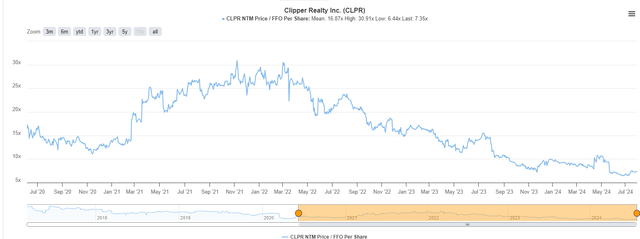Editor’s note: Seeking Alpha is proud to welcome Ethan Wu as a new contributing analyst. You can become one too! Share your best investment idea by submitting your article for review to our editors. Get published, earn money, and unlock exclusive SA Premium access. Click here to find out more »
Matteo Colombo
Investment Thesis
Clipper Realty (NYSE:CLPR) is a REIT that owns and operates seven residential and two commercial properties in Brooklyn and Manhattan (New York City). CLPR is clearly focused solely on NYC real estate, which allows for it to operate with greater expertise in the area than more diversified REITs. Furthermore, NYC is a highly desirable place to live, and a large majority of residents are renters. As such, what CLPR has to offer is certainly in demand.
While its stock has seen a major decline from its IPO price, many numbers seem to indicate that CLPR is performing well: in fact, it currently has over 99% occupancy and its rents continue to grow and reach new highs. While there are a number of valid concerns regarding CLPR, such as its high levels of debt, high-interest rates at debt maturity, and the departure of a major office space tenant, I believe that CLPR is still a worthwhile investment for one main reason: it has quality assets that are notably undervalued, and due to its unique capital structure, the properties are much safer than they appear, as debts from one property will not encumber other properties.
Valuation
I estimated the value of each of CLPR’s properties using the last year of available NOI data (June 2023–March 2024) divided by conservative cap rates of 5% for residential buildings and 8% for office buildings (estimating the value of the Dean Street property based on the neighboring 1010 Pacific). This estimate would suggest that the total value of these properties sums to about 1.51 billion. With its current debts totaling around 1.24 billion, and a total of ~46 million shares, the implied value of a single share in CLPR is 5.82 dollars ([1.51-1.24]/0.046), substantially above what it currently trades at. However, at residential cap rates of 4% and 3% (holding the office cap rate constant), CLPR’s value explodes – being worth around $12.50 and $23.50 per share, respectively.
|
Property |
NOI (TTM) |
Cap Rate |
Value |
Loan Balance |
NAV |
|
143 Livingston |
9,911 |
0.08 |
123,888 |
100,000 |
23,888 |
|
250 Livingston |
12,441 |
0.08 |
155,513 |
125,000 |
30,513 |
|
Flatbush Gardens |
20,922 |
0.05 |
418,440 |
329,000 |
89,440 |
|
Tribeca |
21,217 |
0.05 |
424,340 |
360,000 |
84,340 |
|
Aspen |
3,489 |
0.05 |
69,780 |
60,606 |
9,174 |
|
10 West 65th Street |
2,282 |
0.05 |
45,640 |
31,741 |
13,899 |
|
Clover House |
4,625 |
0.05 |
92,500 |
82,000 |
10,500 |
|
1010 Pacific Street |
3,718 |
0.05 |
74,360 |
80,000 |
-5,640 |
|
Dean Street (estimate) |
5,200 |
0.05 |
104,000 |
70,649 |
33,351 |
|
Total: |
83,805 |
1,508,461 |
1,238,996 |
269,465 |
(All numbers in thousands, except for cap rates)
Furthermore, this quick estimate notably underestimates (possibly by as much as 50%) the value of 1010 Pacific, as it uses the lower NOI numbers from recent quarters when it was not yet fully leased (1.6 million in Q1 2024 vs 0.5 to 0.8 million in Q2-Q4 2024). As such, in my opinion, this rough estimate may even be rather conservative, undervaluing certain properties and discounting the consistent trend of yearly NOI growth. More broadly, my view is that these properties are all located in valuable areas (Brooklyn and Manhattan) that will continue to retain their demand for the foreseeable future – and so their values should be fairly stable.
NTM CLPR Price/FFO per Share (TIKR.com)
FFO can also be used as an alternative metric to evaluate CLPR.
As seen in the graph above, CLPR is essentially trading at an all-time low in terms of its NTM Price/FFO per share, suggesting that the current price, in my opinion, is an excellent time to buy in. More directly, CLPR’s FFO has shown consistent quarter-over-quarter growth. Overall, I believe that FFO and NOI both paint a clear picture that CLPR is notably undervalued at the moment.
Risks
While I believe that CLPR is an attractive investment opportunity, it also faces challenges in several different areas as outlined below.
Debts And Maturities
A major concern is the large amounts of debt CLPR has, which seems to be a key reason for the market’s pessimism and resulting price decline. However, it is important to note that each property is well-protected against said debt, as loans are only tied to each individual property, so other properties are not at risk as collateral, as stated by the CEO: “Our operating debt is 91% fixed and average rate of 3.87% and average duration of 4.9 years is non-recourse, subject to limited standards of car amounts, and is not cross-collateralized. We finance our properties on an asset-based basis and not cross-collateralized.” Not only is the debt largely fixed at low rates, with this debt structure, prudent management will prevent poorly-performing properties from dragging down the business as a whole. Thus, the market’s pessimism seems somewhat unfounded, as the debt has a simple and effective solution: defaulting on the loans of underperforming properties would wipe away challenging debts with few repercussions, and CLPR would still remain undervalued when comparing its intrinsic value to market price.
Of course, it must be the case that several properties are profitable for CLPR in order to realize its value. Currently, NOI is substantially higher than interest payments on all properties with the exception of the unopened Dean Street property, signaling at least a reasonable amount of health under the status quo. Furthermore, much of the debt is locked in for several years at reasonable rates. Three of the four biggest loans are below 3.7% (maturities 2029-2032), while the remaining is at 4.5%, and set to mature relatively sooner in 2028. As for the higher interest construction loans on Pacific and Dean Street, they are set to come due much sooner in 2025 and 2026, when they will be able to be converted into mortgage loans with substantially lower rates. Finally, as for the principal repayment, over 1 billion of the total 1.2 billion debt is not due until 2028 and beyond (~400 million in 2028, ~600 million in 2029 or later). As such, risks regarding interest rate, refinancing, and/or principal repayment for CLPR will not be a serious concern until 2028 at the earliest.
Dividend
Currently, CLPR provides a sizable dividend equivalent to 10.05% annually that has never been cut. Of course, CLPR only went public in 2017, so the record is not truly extensive, but it is impressive that the dividend was maintained through the COVID pandemic. Nonetheless, the dividend should only be seen as a bonus, particularly considering the potential of a future dividend cut caused by CLPR’s high debt or office tenant departure. Essentially, the dividend is certainly attractive at the moment, but if you are looking for a secure dividend stock, CLPR is not the right choice. The significant undervaluing of CLPR’s assets is the focus of this article and the main reason I have bought in, and the presence of the dividend (or lack thereof) does not notably affect my investment thesis.
Office Space
While office space has seen serious declines recently, CLPR’s exposure to office space is not overly high, as the two office buildings (141 and 250 Livingston) comprise about a quarter of total NOI, and CLPR’s newer developments show a clear emphasis on pure residential properties. The current tenant at 250 Livingston is set to depart in August 2025, but 141 Livingston is currently in talks for an extension. Additionally, I believe that these office buildings have the potential to be converted into residential units due to their older construction designs if CLPR desires to entirely move out of office space – in fact, 250 Livingston already has 36 residential units. More extensive conversions have already been successfully completed in NYC, so this should be a viable possibility for CLPR. Other alternative solutions could be lowering rents to attract new tenants, or simply to default on the loan and walk away (with zero impact on the more stable and successful residential properties), an option unavailable to REIT’s with larger holdings in commercial office.
Conclusion
In short, my view is that the attractiveness of CLPR lies in the undervaluing of its assets. It seems that the market has significant concerns and pessimism regarding its debts; however, CLPR’s capital structure is well-equipped to deal with poorly-performing properties, as defaults on one property do not extend to others; furthermore, it does not seem that said debt will pose a major threat until 2028. As for the office buildings, CLPR may be able to remodel them into residential properties or simply lower rents to attract new tenants as needed. Another minor concern may be found in the unfinished Dean Street property: it is anticipated to finish construction within this year, but it is possible for unforeseen complications to occur. Essentially, I see the main risks of CLPR as high-interest rates at debt maturity and difficulties in effectively utilizing its office space. Finally, its intrinsic value may vary greatly based on the cap rates in NYC, with my estimates (that already discount the value of 1010 Pacific) ranging from a low of 5.82 dollars to as high as 23.50 dollars. Ultimately, I would categorize this stock as a buy.

